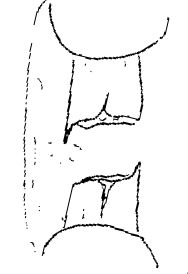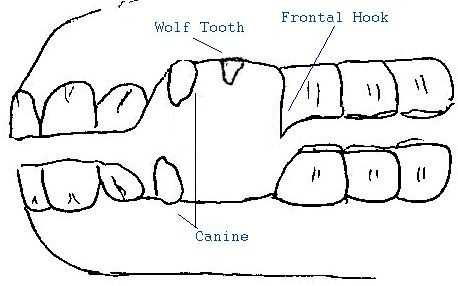We had Dr Shaefer out yesterday to attend to Miss Honky Tonk's teeth, most specifically her nasty underbite.

I'm proud to say she did really well and behaved as well as a little ass should under heavy sedation. In addition to the "sow mouth", she had some points and hooks that needed to be taken down too.
For those of you not familiar with all of this, it's just another part of the necessary maintenance required to keep our equines healthy. The horse's mouth is designed with the upper teeth set just slightly wider than the lowers. This, combined with a slight circular chewing motion, can allow the teeth to wear down in an uneven fashion and cause discomfort to the horse's mouth.

Those points and hooks can get to be razor sharp and do a fair amount of damage to the horse's cheeks. I don't know about you, but I'd be awfully crabby if my mouth bled every time I ate.
A proper mouth should line up like the sketch below, but poor Honky's doesn't. The front teeth are used for grabbing and tearing the grass from the ground (and fingers from your hand if you're not careful), but since hers don't line up, there's nothing for the bottoms to wear against. The sketch also points out frontal hooks, of which, Honky had four fine examples. Since her bottom jaw is pushed forward, her first molars on the bottom also had nothing to wear against, so they kept growing uninhibited. The picture above is a good shot of the frontal hooks.

So the vet sedates the horse (or ass in this case), holds the mouth open with a scapula, sets the weary head in a saddle - not that kind of saddle - a dental saddle, and grinds the points down with a powered grinder. It's essentially a modified Dewalt drill. The grinding wheel is small, maybe the diameter of a quarter, and you can press it to your hand without discomfort. But it sure does a number on those ivories.
Does it hurt?
Well, I didn't feel a thing. But seriously, a horse's nerve endings stop about right at the gum line. Everything after that is just tooth. Not long ago vets used to use manual rasps, but most have gone the way of the power rasp. The manual rasp can be clumsy, and at times can do some damage to the mouth as it slides off of a tooth and crashes into the back of the jaw. The power rasp gets the job done much quicker.
Here's Honky's molars after a good rasping. The points and hooks have all been taken down, and her dental "table" is much more flat. The molars are designed to be uneven and wavy to grind up their food, so the dentist has be sure not to make the table too flat.








6 comments:
Learn something new every day! Dad didn't like horses, so we never had any when I was growing up. Missed out on a lot of knowledge there, eh?
Views I have never seen!
I also learned something new today. I had no ideal that they nneded their teeth worked on. You (I) would think that nature would have taken care of that problem.
Oh, is tht also the same thing as
"floating the teeth?" I have heard that but I don't know what that means.
Hi there.
I found this post (and all the photos) extremely interesting!
How did you go about finding the right person to do the job? I need to call my local vet to see whether they have someone they can recommend. I'm assuming just a standard veterinarian doesn't do this kind of thing. I've started noticing a funny smell in my new donkey, Chester's, mouth. His history is kind of sketchy, so I don't know anything about his past or whether he ever had anyone check out his mouth. I'm worried that maybe he has a bad tooth or something. I know donkeys can be quite stoic about pain.
Boy...she really did have quite the under bite!!! I'm sure she's much happier. Great shots of the procedure too!
So, it's been a year...how's the under bite now?
Post a Comment